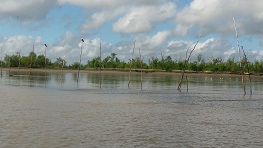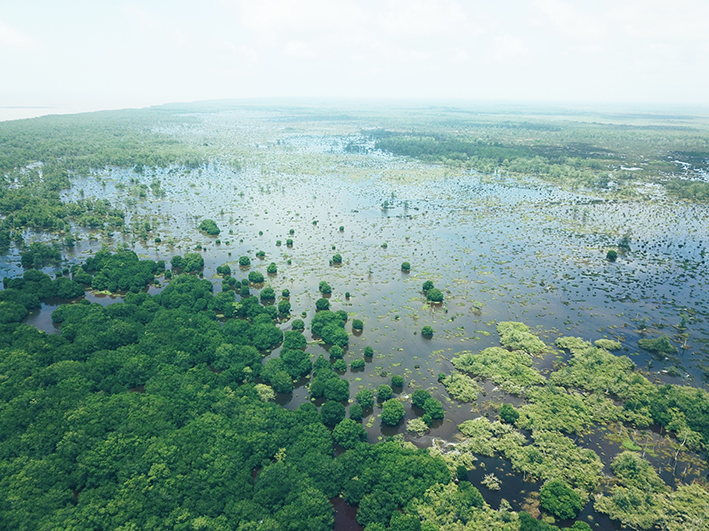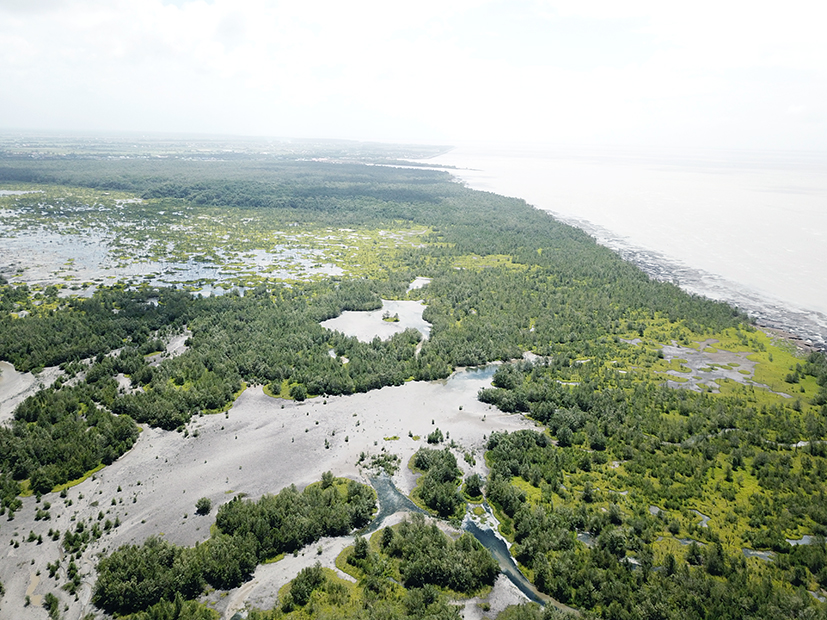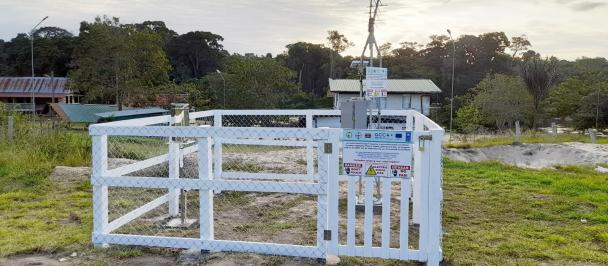Biodiversity in the Bering Hole area, located in the Bigi Pan MUMA (Nickerie district, Suriname) Photo credit: GCCA+ Project, July 2018
Wetlands play a vital role in maintaining many natural cycles and supporting a wide range of biodiversity. Their role in maintaining biodiversity renders them crucial to the agriculture and fisheries sector. Wetlands purify our water and act as a natural sponge against flooding and drought, thus functioning as a water source and purifier. They also protect our coastlines and are therefore key in combatting the effects of climate change[1]
Between 1900-2000, the world lost almost two-thirds of its wetlands due to drainage, conversion for agriculture, urbanization, and infrastructure such as dams, dykes, harbors, and ports. The trend of wetland loss continues. Which in turn drives biodiversity loss, water and food shortages, devastating floods and fires, coastal subsidence, and erosion. It puts the most vulnerable communities at risk of water-related disasters, exacerbated by climate change. [2]
Aerial view Noord Commewijne/ Marowijne MUMA Photo credit: Foundation for Forest Management and Forest Supervision (SBB), 2019
Celebrated annually on February 2nd, World Wetlands Day aims to raise global awareness about the vital role of wetlands for people and planet. The theme for 2022 is “Wetlands Action for People and Nature” and highlights the importance of actions that ensure that wetlands are conserved and sustainably used.
This day also marks the date of the adoption of the Convention on Wetlands on February 2nd, 1971, in the Iranian city of Ramsar.
Suriname acceded to this convention in 1985 and included on the Ramsar list the Coppenamemonding Nature Reserve, where migratory birds flock to find their food and also to hibernate for the winter. Suriname has multiple Multi Use Management areas (MUMA) and protected areas hosting wetlands, including the following:
- Bigi Pan MUMA
- Noord Coronie MUMA
- Noord Saramacca MUMA
- Noord Commewijne/ Marowijne MUMA
- Wanekreek Nature Reserve
- Galibi Nature Reserve
Aerial view Bigi Pan MUMA Photo credit: Foundation for Forest Management and Forest Supervision (SBB), 2019
The Coppenamemonding Nature Reserve, a large 12,000 ha area situated in the North Saramacca MUMA, is of international value and is the only wetland in Suriname included on the list of wetlands of the Ramsar Convention. (Ramsar site no. 304.)3
Another well-known is the Bigi Pan MUMA, this area encompasses about 68,300 ha of land (partly inundated by fresh or brackish water) and at least an equal area of sea (water)4
The Bigi Pan MUMA is an internationally important area for breeding birds, up to 3,000 pairs of herons, egrets and passage and wintering waterbirds. Impressive numbers of Scarlet Ibis (Eudocimus ruber) and Semipalmated sandpiper (Calidris pusilla) gather at the site. There is limited ecotourism in the reserve and low-level subsistence use by fishermen5
To help mitigate the effects of climate change, affecting our biodiversity, the Global Climate Change Alliance Suriname Adaptation Project (#GCCA+ Project), supported the Mangrove Conservation and Rehabilitation project in Bering Hole, located in the Bigi Pan MUMA (Nickerie district, Suriname) together with the local community of Nickerie and the Anton De Kom University Suriname (ADEK University Suriname) in May 2017. This project was executed with the financial support of the European Union (#EU) and the United Nations Development Programme (#UNDP) and supported by the government of Suriname.
The GCCA+ Phase 2 project also provides ongoing assistance to the National Forest Monitoring system through its support of the mangrove biodiversity monitoring system which includes proposed efforts to establish a national wetland classification system and map due to the close relationship between coastal wetlands and mangrove forests and the relevance of this data to the conservation of mangrove forests in Suriname.
Ms. Verginia Wortel, Head of the Division of Forestry / Acting Head of the Division of Agriculture Center for Agricultural Research in Suriname (CELOS) states that “it’s important for us, as a society, of which the majority is living in and near wetlands, to acknowledge the importance and value of our wetlands”, independent of ethnicity, social standing, and political color
Ms. Wortel also indicates that “the GCCA+ Phase 2 project, with the support of EU and the UNDP, invests in human capital and research on the functioning (intricacies) of complex processes? of wetlands, which will in turn help find climate smart solutions towards conservation and restoration of our wetlands, thus investing in health and wellbeing of people and wetlands.”
“Taking action to promote responsible management of our wetlands is key to the sustainability of wetlands and communities” Ms. Wortel added in conclusion.
Sustainable development can’t be achieved if we don’t take decisive action for its preservation. It is of critical importance that the community is well educated on the most rapidly disappearing ecosystem. “A world without wetlands is a world without water”.
==============
- [1] Source : https://www.wetlands.org/wetlands/why-wetlands-matter/
- [2] Source :https://www.wetlands.org/wetlands
- [3] Basemap source : https://www.gonini.org/
- [4] Source: Bigi Pan Management Plan 2013-2023
- [5] Source: https://rsis.ramsar.org/ris/304

 Locations
Locations



